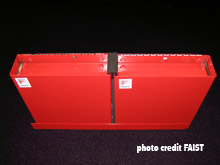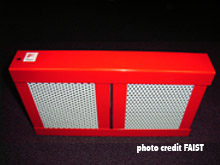Why implement a lining inside a metallic casing, a metallic screen, a partition or an enclosure made of plasterboard or with wood sidings with a sound-absorbing material to improve their acoustic performance?
Absorbent material can increase the sound insulation of a plate on which it is applied (on noise source side).
With its absorption property, the absorbent limits the increase of sound pressure level on noise source side that would occur if the support alone (metal housing, plasterboard, wood plate) was interposed.
With its surface density (if it is not negligible), the absorbent material increases - all other things being equal - the sound reduction index (limits the sound transmission factor) of a thin plate at frequencies for wich the mass law is applicable.
Why implement a lining of a metallic casing, of a metallic duct, a pipe, of a plasterboard partition, of a partition with wood sidings with a damping material to improve their acoustic performance?
A damping material can increase the sound reduction index of a plate on which it is applied.
Thanks to its damping properties, the damping material:
- reduces - other things being equal - the decrease of the sound reduction index (limits the sound transmission factor) of a thin plate for frequencies corresponding to the phenomenon of coincidence
- limits the impact noise associated with the fall of parts (containers, gutters ...) and/or limit the impact noise associated with material being ejected at high speed (duct for waste evacuation, for shavings in suction networks ...).
With its surface density, the damping material increases - all other things being equal - the sound reduction index (limits the sound transmission factor) of a thin plate at frequencies for wich the mass law is applicable.
Which ventilation for an enclosure (acoustic hood)?
The design and implementation of an industrial enclosure - structure enveloping sound source (machine), designed to protect the environment of the sound source (machine) - (carterization of machine tools, housing of noisy equipment or soundproofing building .. .) performing in terms of sound insulation necessitates the involvement of constructions often very airtight and often justifying moderate heat loss.
The ventilation of an enclosure is related to the need of evacuation of heat (calorific energy) dissipated by the enclosed equipment and not always transmitted through the walls of the enclosure.
The required ventilation rate is related to the thermal contributions of equipment installed inside the enclosure and to the performance in terms of thermal insulation of the partitions of the enclosure and also to the allowable temperature rise (difference between the temperature within the enclosure and the temperature of the air of the ventilation system).
With regard to thermal contributions in the workplace: those related to lighting, to computer equipment ... are generally minor, while those related to the process itself are often major and sometimes impacting the quality of the process itself: in the corrugated cardboard industry (where corrugators are concerned) or in printing industry (where rotary presses are concerned) for example. Where applicable, the presence of openings in the enclosure, permanent (passages for flow of raw material e.g. : wood entry for a planer) or temporary (periodic opening of doors by an operator, exit through enslaved hatches of finished products for example outlet for blocks for of a concrete press) are taken into account as well as the air flow necessary for the process itself (in terms of air to be introduced into the enclosure for drying or cleaning with compressed air for example) or the flow rate evacuated through a network of dust or chip discharge (woodworking machines for example) or suction trimmings (processing machinery in corrugated cardboard industry, for example) if they exist.
As far as thermal contributions in the energy sector are concerned, (and in particular: in the case of power generation units), their treatment can be a major aspect for the success of a soundproofing project, enabling enclosed equipment to operate in conditions as foreseen by the manufacturers without exceeding the acceptable temperature limits: when one or more fan(s), engine(s), compressor(s), generator(s), gas turbine(s) are involved, for example. Are taken into account also the needs of combustion air (for an engine or a gas turbine for example) that may require the creation of an aeraulic circuit separate from the ventilation circuit of the enclosure with dedicated filtration and silencing equipment (silencer). For such projects, a comprehensive specific study in terms of aerodynamics is required.
The existence of a ventilation system in an enclosure generally leads to the need to implement silencers (one for the air inlet and one for the air outlet to limit the propagation of noise through these openings) and sometimes to have to silence the fan wich sound power can sometimes be of the same order as that of other noise sources for which the enclosure has been considered and may lead to the implementation of soundproofing equipment also consistent - if not more consistent - as for the treatment of the partitions of the enclosure . The installation of enclosures in some particularly hot environments (in relation to climate, or due to the presence of heat sources - nearby - such as a furnace or as some processes) may necessitate the implementation of equipment of air conditioning.
Which performance in terms of sound insulation for an enclosure (soundproofing hood) ?
The performance in terms of sound insulation of an enclosure (acoustic hood) - structure enveloping a sound source (machine), designed to protect the environment of this sound source (machine) - is very frequency dependent and is primarily related on the one hand to the performance of acoustic insulation panels (characterized by their sound reduction index) and also where appropriate to that of the silencer (for ventilation) and also to the number and to dimensions of cuts and openings, and on the other hand to the sealing imperfections and to structure born (bridging) sound transmissions.
This performance can be expressed in terms of difference (with and without the enclosure) of overall A-weighted sound pressure levels or of sound pressure levels in octave bands at specified locations (such as maximum value at 1 m from the walls of the enclosure, average value on an enveloping surface, value at a workplace) - also known as acoustic pressure reduction - of in terms of difference of overall A-weighted sound power levels or of sound power levels in octave bands of the enclosure - also known as acoustic power reduction or insertion loss od the enclosure-
For orders of magnitude (and with respect to a noise spectrum like "pink noise"), a level difference of up to 10 dBA can usually be obtained without special requirements, while a level difference from 10 to 20 dBA requires a standard enclosure without important leakage, while a level difference of 20 to 30 dBA requires a standard enclosure with sealing joints carefully implemented, a soundprrofing floor and a resilient mounting (enclosure with a vibration control system), and while a difference of 30 to 40 dB involves high performance enclosures carefully designed and installed (a level difference even higher shall involve a special construction).
The prediction of acoustic performance (for airborne sound) of an industrial enclosure can be performed with the simulation software SILDIS®®.
Verification of acoustic performance of an enclosure can be conducted (depending on the case) in accordance with the standard ISO 11546-1 Acoustics - Determination of sound insulation
performances of enclosures - Part 1: Measurements under laboratory conditions (for declaration purposes) or in accordance with the standard ISO 1546-2 Acoustics - Determination of sound insulation performances of enclosures - Part 2: Measurements in situ (for acceptance and verification purposes).
Which metallic sound insulation panels for an enclosure (soundproofing hood) ?
With regard to metallic sound insulation panels (also called soundproofing panels) used for current applications in industrial soundproofing such as building an enclosure (acoustic hood) - structure enveloping a sound source (machine), designed to protect the environment of this sound source (machine) -, they generally consist of an outer casing (usually made of non-stainless steel, most of the time: with paint) and of an absorbing filling (quite often: mineral wool) covered by a surfacing (mostly: a fiber glass) and also a perforated protection (mostly: galvanized steel). For the outer casing, a powder coating usually provides the best possible protection against corrosion: classification up to C5 according to ISO 12944.

sound insulation panel for enclosure (sounproofing hood) |

sound insulation panel |
In some cases, the envelope of acoustic insulation panels of cabins can be made of stainless steel (SS 304, SS 316) or aluminum.
As required, the absorbing filling may consist of acoustic foam or polyester wool and, for some applications, be protected by a waterproof surfacing (polyurethane film and for extreme cases: painting).
In order to increase the sound reduction index in a given frequency range, an intermediate plate (usually made of steel) and an additional spacing absorbent layer may be inserted into the acoustic insulation panels, the performance of such insulation panels being based on the double shell effect.
For specific cases, a damping material (viscoelastic) can be incorporated.
Acoustic performance of sound insulation panels for cabins (in terms of sound reduction index) is very frequency dependent, being related mainly (besides the quality of the joint between panels basing their airtightness ):
- for panels with simple shell effect: mainly to the total mass density
- for panels with double shell effect: mainly to the mass density of each of the facings and to their spacing (the mass density of the inner absorbing lining may also be accounted if significant)
The prediction of acoustic performance of the partitions of an enclosure can be performed with the simulation software SILDIS®.
The verification of acoustic performance of the partitions of an enclosure can be conducted in accordance with ISO 140-3 Acoustics - Measurement of sound insulation in buildings and of building elements - Part 3: Laboratory measurements of airborne sound insulation of building elements.
ITS sells metal acoustic insulation panels for enclosures / soundproofing hoods for all kinds of applications.
Spread the word !
More Articles
- Which are the input data useful for sizing the partitions of an enclosure (soundproofing hood)?
- What acoustic regulations for noise limitation in educational and training institutions ?
- What acoustic regulations for the limitation of noise in housing - residential buildings ?
- Which environmental protection against noise in France and in the European union?
Page 8 of 12